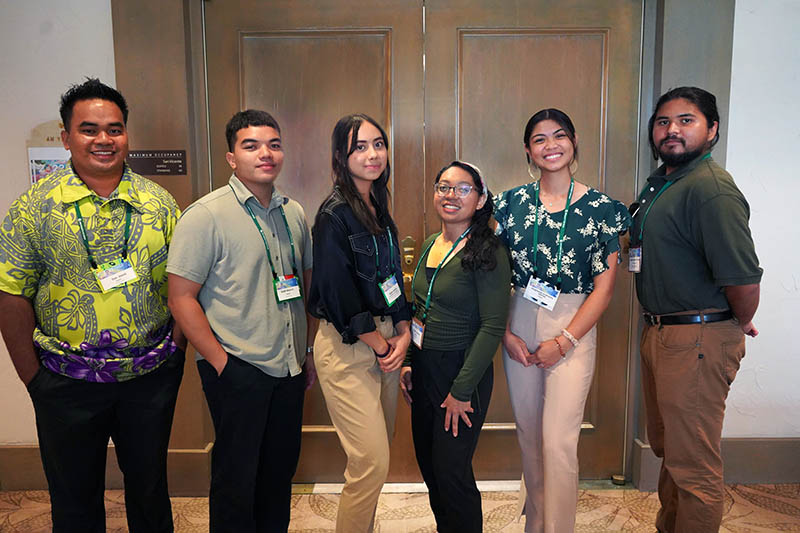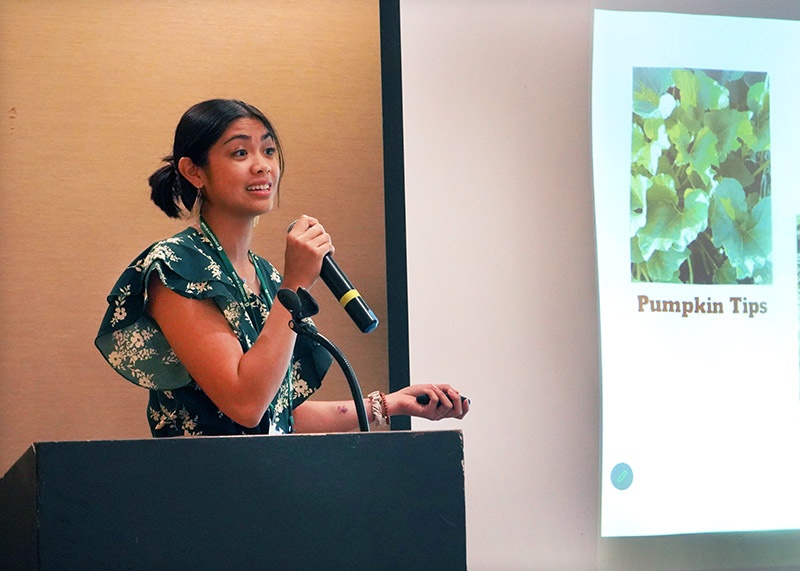Agriculture students promote health properties of local veggies and honeys at CIS
Agriculture students promote health properties of local veggies and honeys at CIS
Agriculture students promote health properties of local veggies and honeys at CIS
4/21/2023

To Pacific Island residents, the term “superfood” might sound expensive or hard to get. A shopper might assume that any food with exceptional nutrients and health benefits has to be shipped in from far away, giving it not only a high price tag, but also a short shelf life. But agriculture students from the University of Guam at the UOG Conference on Island Sustainability on April 13 showed that Guam and the Marianas have their own supply of high health-benefit foods, including local veggies as well as local honey.
Local honeys assessed for quality and health properties
Agriculture major Sophie Santos presented on her research project under UOG food scientist Dr. Jian Yang: a first-time assessment of local honey to determine its beneficial properties for health as well as its quality, according to international standards.
She assessed 12 samples of Guam and Saipan honey and found that the content of phenolics — chemical compounds that promote anti-inflammation and serve as potential antioxidants — was very diverse, which can be attributed to the various flower and nectar sources. One honey from Saipan was even comparable in phenolic content to New Zealand’s famous Manuka honey, although none of samples contained methylglyoxal — the unique chemical in Manuka honey that provides its wound-healing and antioxidant properties.
She also found that, as with honeys from other locations, the local honeys that were redder in color had higher phenolic and antioxidant levels.
Overall, her study found that local honeys exhibited levels of phenolics and antioxidant activity making them a beneficial part of the diet to reduce oxidative stress. Additionally, her assessments found that local honey samples meet internationally recognized quality and safety standards for human consumption.
Most store-bought honey has been adulterated with sugar solutions, she said, whereas locally produced honey is pure.
“I would highly encourage all of us to invest in our local beekeepers because it supports them but also supports our health,” she said.
Yang and Santos plan to submit a manuscript for publication to report the safety and quality of local honey.
5 ‘superfoods’ that grow abundantly in Guam

Chloe Santos, Scott Davis, Don David, Kaelan Arciaga, and Stephenie Santos — junior and senior agriculture students with concentrations in tropical agriculture production — presented a booklet listing 50 Pacific Island vegetables that fit the bill and highlighted five, in particular, that are commonly available:
- Kale: High in protein, fiber, calcium, anti-cancer properties, omega-3 fatty acids
- Turmeric: High in iron and contains anti-cancer, anti-inflammatory, and anti-oxidant properties
- Taro: High in fiber, potassium, carbohydrates, and vitamin B6
- Yams: Rich in carbohydrates, vitamins A and C, fiber, and minerals
- Chinese cabbage (bok choy): High in fiber, and vitamins A, C, K, and B6
- Water spinach (kangkong): High in vitamin C, potassium, iron, and antioxidants
“We can redefine superfoods. […] It doesn’t just have to be this labelled, imported product that you find on a shelf in a nutritional store, but superfoods can be this wide range of crops that can be grown here in the Pacific Islands,” Chloe Santos said.
The group is working to make a booklet available for public reference that lists locally grown “superfoods” and their nutritional values.
“We can return to the depths of our own resources here and start thinking about growing locally in our own backyard or supporting our farmers and checking out the Farmers Co-Op. The next time you think of superfoods, think of local veggies,” Chloe Santos said to conclude their presentation.
